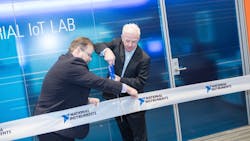The Internet of Things (IoT) concept appeals to many industrial companies because it opens up a new world of business, operations and process improvement opportunities without requiring an entirely new set of technology investments. While there are obvious concerns about security, the bigger hurdle for most companies is simply understanding how the IoT concept can work for them.
Even though IoT is enabled by well-understood and long-used technologies, there’s simply not an abundance of application references to which companies can turn to better understand what it could mean for them. At least not yet.
In the interim, a proving ground of sorts is needed—and that is what National Instruments (NI) has established with the opening of its Industrial Internet of Things (IIoT) lab.
Focused on intelligent systems and the connection of operational and informational technologies and the companies working with them, the lab will intially concentrate its efforts on advanced control for manufacturing, asset monitoring for heavy equipment, and microgrid control and communication.
At the lab’s opening, NI’s Jamie Smith said, “The IoT is built with things, such as motors and drives. These things need to be equipped with world class sensors and those sensors’ data need to be processed to extract insights at the edge or be passed on to an IT network. No one company can do all this alone. You need an ecosystem of collaborators. This lab is a physical manifestation of that collaboration ecosystem.”
Companies working with NI to sponsor and collaborate with the IIoT Lab include Analog Devices Inc., Avnu Alliance, Cisco Systems, Hewlett Packard Enterprise (HPE), Industrial Internet Consortium, Intel, Kalypso, OPC Foundation, OSIsoft, PTC, Real-Time Innovations, SparkCognition, Semikron, Viewpoint Systems and Xilinx.
Smith highlighted one of the lab’s key agendas—to educate users on the viability of IoT. “We want our partners to bring their customers to the lab to show the viability of IoT and that the technologies are here and ready now,” he said.
Gerald Kleyn, a senior director at NI’s IIoT lab partner HPE, explained HPE’s complementary role with NI around IoT. “HPE sees IoT as things you want to connect with—and we're good at IT connections. But we didn't have all the connections points to the industrial space,” he said. “NI opens that up to us by converting industrial analog inputs into digital data streams we can act on.”
Explaining how the IIoT Lab is outfitted for flexible and collaborative work on IoT projects, NI’s Brett Burger noted that the lab is located near NI’s machine shops and demo building offices. “The lab has 50 network patch connections, 20 of which connect to the NI network and 30 are punch-throughs that connect to an adjacent server room that NI controls and to which public access can be allowed,” Burger said.
The lab also has a GPS drop for applications requiring global synchronized measurement, three-phase power for manufacturing applications such as robotics, and a three-phase microgrid connection to Austin Energy for project testing involving the power grid. Burger said these three areas will represent the core focus for the lab for the next few years. He added, however, that “nothing in this lab is finished. At this point, we’re laying the foundation for collaboration and continuous development of the lab.”
As a proof point of NI’s intent for the lab’s continuous development, Burger pointed out that the lab’s flexible power and networking outlets can easily be physically relocated and expanded as needed based on the requirements of the lab’s projects. “We built the lab for ultimate flexibility—even the network and power ports are flexible so they can be moved without ripping up sheetrock,” he said.
The first test of the lab—beyond the establishment of the Time Sensitive Networking (see video below), asset monitoring, and microgrid control and communication demos highlighted at the launch—will focus on Time Sensitive Networking (TSN) device testing. Burger said that at least 20 representatives from NI’s TSN partners are coming to the IIOT Lab’s plugfest this week to verify that their devices work within the TSN framework using the lab’s resources.
Commenting on the current state of IoT awareness across industry, Burger said, “End users today aren’t looking for specific IoT solutions, but they have problems they're looking for IoT to fix. And at the executive level, industrial companies understand that IoT will be a game changer. They know that, if they're not focusing here now, they’ll be at a disadvantage.”
The video below shows NI's Time Sensitive Networking demo presented during the opening of the company's Industrial IoT Lab. The demo highlights how TSN prioritizes control network traffic over IT network traffic on converged IT/OT Ethernet networks to ensure that there is no impact on production systems.
Leaders relevant to this article:


